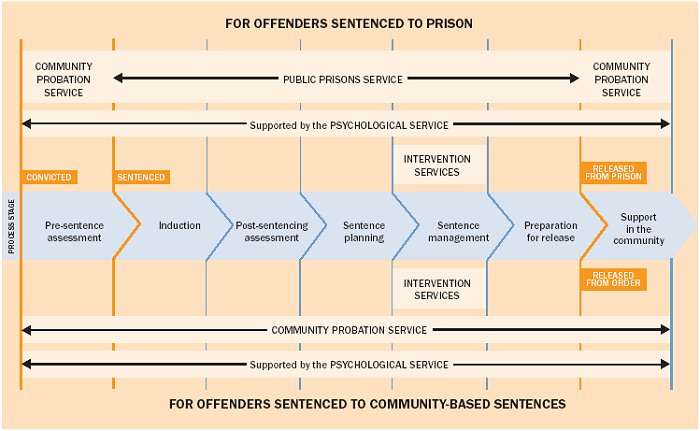Approach to Managing Offenders
The Department manages offenders through an integrated approach that applies across all sentence types, sentence lengths and locations.
When offenders enter the corrections system, there is a process to guide what happens to them during their sentence, how their needs are identified and managed and what follow-up support is required once they have finished their sentence. The offender management process is illustrated by the following diagram.
Table 5: Offender Management Process

The integrated approach to the management of offenders is underpinned by tools for assessing an offender’s risk of re-offending and their particular criminogenic needs. For higher-risk offenders, needs are closely matched with interventions that focus on rehabilitation. For lower-risk offenders, reintegration into the community is the key element of an approach designed to support a transition to a crime-free lifestyle.
As a first step, many offenders may also need some assistance to motivate them to address their offending behaviour. In such cases, the initial focus will be on either cognitive-based programmes or a tikanga-based programme. Should there be a consequent improvement in motivation, the offender may go on to have interventions targeted at their criminogenic needs as they relate to the cause of their offending.
Offenders, depending on their risk status and criminogenic needs, will receive interventions from the range outlined in the following diagram.
Table 6: Integrated Approach to Offender Management
|
Serving a Safe Sentence |
Equipping for Self-sufficiency |
|
Safe secure and humane containment |
Education and employment |
|
Aiming to Change Behaviour |
Removing Blockages to Remaining Offence-free |
|
Responsivity/Motivational Rehabilitation |
Reintegration |
The design of the interventions and associated business processes has been based on studies of ‘what works with offenders’ both internationally and in New Zealand,1 and takes into account the New Zealand environment, and the nature and characteristics of the offending population. The best results are when the right person receives the right intervention, in the right situation, at the right time – and gets good support from community, friends and family for maintaining their new behaviours, both during their sentence and once their sentence has been completed.
In general, overall positive results in reducing re-offending come from being able to identify:
- people who are highly likely to re-offend upon release from their current sentence (that is, have a high risk)
- the factors such as attitudes, thought processes, habits and addictions that relate to offending
- a person’s willingness and ability to benefit from a therapeutic programme
- the right type of intensive, structured and long-running programme – real change is never easy or quick, even when the person is willing
- the right time for a programme to occur, including support following completion.
The Department’s approach is enabled by a philosophy of ‘Active Management’, which is the interaction of staff and offenders for the purpose of effective sentence management. As such, it involves skilled and knowledgeable staff (who understand the specific risks and needs of each offender) interacting and responding to offenders in a positive way in order to achieve the best possible outcomes.
1 The principles of the psychology of criminal conduct are found in Andrews and Bonta, The Psychology of Criminal Conduct (3rd Edition), 2003. The New Zealand experience is reported in the departmental publications Let there be Light, When the Bough Breaks, Montgomery House Evaluation and Driving Offender Treatment Programme Evaluation.

